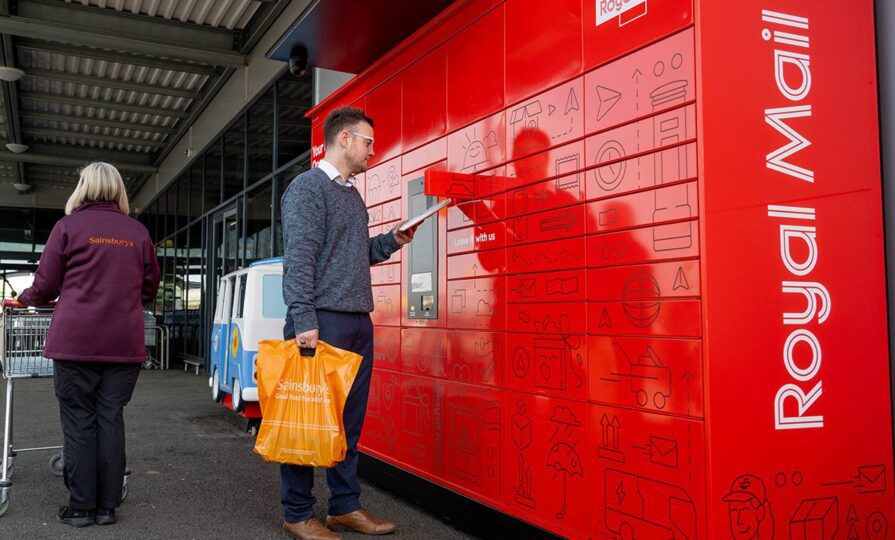What do supermarkets stand to gain from hosting parcel lockers?
Click, collect, done. That’s how it works. Customers want speed, control, and convenience – often without human interaction. We explore how lockers can give them just that.

Register to get 1 free article
Reveal the article below by registering for our email newsletter.
Want unlimited access? View Plans
Already have an account? Sign in
Parcel lockers are everywhere now – outside supermarkets, in petrol stations, by train lines – and the numbers back this up. According to recent data from Statista, in 2023, 40% of UK adults used them. The year before, it was 30%. A decade ago, it was barely half of that. Gen-Z is leading the charge, with 71% using lockers, while 68% of Millennials follow close behind. InPost alone handled over 93 million parcels in 2024, doubling its figures from the year before. Their locker network grew from 7,000 locations to 13,000 in just 12 months.
In an attempt to keep up, Sainsbury’s recently teamed up with Royal Mail as a way to compete with the likes of Amazon planting parcel lockers everywhere. With more and more people shopping online, this is no longer a gimmick. Parcel lockers have become a permanent fixture in the UK’s logistics landscape – and importantly – an excellent way for people to receive their deliveries on their own terms.
But what do retailers stand to gain by having these lockers on their premises?
“Parcel lockers offer numerous benefits for retailers. The most obvious is the potential to drive additional footfall, as customers often combine parcel drop-offs with picking up items, whether on an impulse or planned basis, enhancing the overall customer experience,” says Claire Wallis, consumer goods and retail director at BearingPoint. “Moreover, depending on the agreement with the locker provider, retailers can gather valuable data on delivery preferences and collection times, linking these insights to store performance and footfall.”
Wallis has seen “reported and tangible evidence” from InPost back in 2024 that 54% of locker users followed their way into stores to make a purchase, with baskets surpassing £20 on average.
Click, collect, done. That’s how it works. Customers want speed, control, and convenience – often without human interaction. Lockers give them that.
Inside, the shopkeeper watches. When a customer arrives with the intention of retrieving a package, there’s every chance that they will linger to browse. Maybe they buy something, maybe they don’t – but they came, and that’s something.
Nigel Cattermole, director of business solutions at same-day distribution company CitySprint, underlines the lockers’ role in driving customers to retail sites. “Lockers can increase footfall and drive incremental spend from customers who visit the site to collect or drop off parcels,” he says. “Customers visiting a locker at a petrol station may also choose to purchase fuel during the same visit, thereby consolidating trips and boosting sales. Similarly, large locker banks at supermarkets can drive additional footfall to that store, potentially diverting customers from competitors that do not offer such services.”
Wallis agrees, noting she has seen “reported and tangible evidence” from InPost back in 2024 that 54% of locker users followed their way into stores to make a purchase, with baskets surpassing £20 on average. “So that’s a clear benefit, as lockers provide a destination for convenience shopping,” she says.
According to Serhat Kyuchuk-Pakyuz, a former Amazon logistics manager and now CEO of RideLogix, delivery to pick-up points is currently 25% cheaper than home delivery. He says: “This makes offering free shipping – a vital incentive for six in 10 shoppers – more feasible for retailers. Lockers can also act as cost-efficient returns hubs – they turn the often-painful returns process into something quick and convenient.”
Retailers with parcel lockers often secure consistent revenue streams, but it’s not just about the rent or the per-item fees.
But none of this happens without a deal. Retailers need a reason to host them.
“Parcel lockers installed externally typically operate on a rental agreement for the physical space, rather than a per-transaction commission,” explains Cattermole. “In contrast, when convenience stores act as parcel collection and delivery points… retailers usually receive a fee for each parcel handled.”
Retailers with parcel lockers often secure consistent revenue streams, but it’s not just about the rent or the per-item fees. As Wallis notes, retailers can also earn guaranteed rental income from the parcel locker operator, adding that “additionally, for those who traditionally operated in-store parcel collection services, lockers simplify the process, reducing the operational burden”.
She continues: “There are several commercial benefits that retailers can negotiate into agreements. Examples include revenue sharing, fixed monthly rental fees for hosting locations, and commission-based models based on transactions per customer.”
Vineta Bajaj, ex-Ocado and current CFO at Rohlik Group, highlights another benefit of lockers for retailers: “They bring in footfall that might not otherwise come through the door. Once a customer is on-site to collect a parcel, there’s a clear opportunity for impulse purchases – whether that’s topping up groceries, grabbing a coffee, or picking up a few essentials,” she says.
As Bajaj notes, supermarkets already have the infrastructure – parking, security, extended opening hours. “So installing lockers doesn’t require a huge investment,” she says. “In return, there’s the potential for rental income from logistics providers, along with that all-important uptick in convenience-led spending.”
But space is at a premium. The cost of prime retail space is ever-rising, and not all sites can easily accommodate lockers.
In essence, the commercial models around parcel lockers are as varied as the businesses they support. Whether it’s rental agreements, fees per parcel, or revenue-sharing models, retailers have a number of ways to benefit. But, like all business ventures, it boils down to the balance between cost, effort, and the customer who walks through the door.
For any of this to work, lockers need to be accessible – for customers and for couriers.
“Several practical considerations need to be addressed when installing lockers,” says Cattermole. “These include ensuring access to power, positioning the lockers in safe and accessible areas for customers, and providing suitable access for delivery drivers, who often need to carry multiple items from their vehicles to the locker bank.”
For retailers, the size and location of the locker installation are critical. Wallis explains, “High footfall areas, such as those with car parks and near entrances and exits, are ideal for locker placement due to their visibility and convenience. When assessing the overall value provided by the square footage, it’s important to consider replacing lower revenue-driving areas with lockers, as they can enhance customer satisfaction and streamline operations.”
But space is at a premium. The cost of prime retail space is ever-rising, and not all sites can easily accommodate lockers. Neil Goodman, supplier manager at Staci UK, adds: “Several factors must be considered, including site accessibility, integration with existing fulfilment and delivery networks, and ongoing maintenance. Placement must allow for easy access by customers, couriers, and increasingly by low-emission delivery vehicles such as electric vans and cargo bikes.” As demand for lockers increases, finding suitable space – particularly in dense, urban areas – becomes more challenging.
The broader effect of parcel lockers is seen in the reduced need for home deliveries, which also helps with congestion in urban areas.
As consumers demand greener options, parcel lockers also reduce the environmental footprint of last-mile logistics and are part of a broader movement to minimise emissions, cut down on traffic congestion, and streamline the final stages of delivery.
Josh Pitman, managing director of Priory Direct, highlights how lockers directly address environmental concerns. He says: “Parcel lockers reduce the need for multiple failed delivery attempts, which are costly and environmentally damaging. If a customer misses a delivery, the carrier has to return, often emitting more carbon with each trip. Lockers centralise parcels, creating efficiency and cutting down on carbon emissions.”
Goodman agrees, noting that when lockers are deployed in areas that are close to residential zones, they help to consolidate deliveries. “Instead of making multiple trips to individual homes, delivery drivers can make fewer stops, lowering their carbon footprint and optimising their routes,” he says.
The broader effect of parcel lockers is seen in the reduced need for home deliveries, which also helps with congestion in urban areas. “Rather than each courier making individual stops at people’s homes, lockers reduce that complexity. Not only do lockers create efficiencies, but they also contribute to lowering the emissions that come from unnecessary vehicle trips,” Kyuchuk-Pakyuz adds.
Sustainability aside, shoppers have grown accustomed to fast, flexible delivery options, which is exactly what lockers provide. “For many consumers, parcel lockers offer a solution to delivery issues – whether it’s for items requiring a signature, or simply because they’re not home during delivery windows,” Pitman points out. “Lockers give them more control over when and where they pick up their packages. It’s this flexibility that’s driving increased adoption.”
The integration of artificial intelligence, better location targeting, and new delivery models all point to one thing: parcel lockers will continue to evolve to match the growing needs of consumers and retailers.
The future of parcel lockers looks promising, with innovation on the horizon. Kyuchuk-Pakyuz highlights the shift in technology. He says: “We are moving towards a future where the locker ecosystem is becoming more than just a passive storage solution. Lockers will play a critical role in streamlining supply chains by integrating with automated delivery networks and even smart city infrastructure. It’s a transition towards a fully integrated, data-driven logistics system.”
Wallis sees the growth potential as well. “There’s a real opportunity for lockers to become a more prominent part of our daily lives,” she concludes. “We’re seeing increased integration of lockers into public spaces, and as more players enter the market, we’ll see a broader range of solutions catering to diverse consumer needs. Expect lockers to evolve, becoming smarter, more user-centric, and offering even more choice.”
The integration of artificial intelligence, better location targeting, and new delivery models all point to one thing: parcel lockers will continue to evolve to match the growing needs of consumers and retailers. The next phase promises an even more streamlined, connected, and customer-centric experience.
As Kyuchuk-Pakyuz aptly puts it, “we’re seeing the start of an evolution, not just a trend. The next chapter in parcel locker technology will redefine how goods are distributed and retrieved.”







